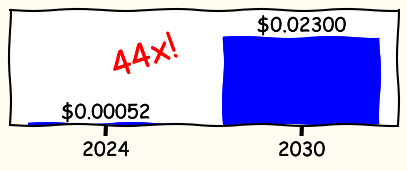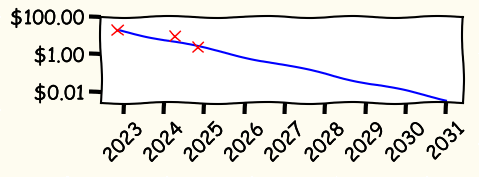The Expensive Internet hypothesis
There is a chance that the future internet will be more expensive than today’s, simply due to the growing capabilities of AI agents. Specifically, I expect that we’ll end up with what I’ll term the Expensive Internet—the idea that every mundane digital action will require support from complex control agents because human-level digital crime will become so cheap and commonplace.
 The cost of receiving 20 emails won’t be the same in 2030
The cost of receiving 20 emails won’t be the same in 2030
Receiving an email today
Let’s consider the cost of receiving an email today. Suppose an email with a small file attached is about 225 KB, and it’s stored with two backups.
For cloud storage, we use AWS estimates for the email stored over three months, an initial save (PUT request), five views by the user (GET requests), free inbound data transfer, and internal file transfer for the backups at about $24e-6.
For compute, we estimate t3.micro instance costs for 350ms total for spam filtering, virus scanning, and routing and delivery at a total of about $10e-7. The energy costs for all of the above ends up at about $77e-8 for $0.10 per kWh.
This puts our total for receiving and handling an email today at $26e-6.
That’s 2.46 hundred-thousands of a cent. I’d say that’s a reasonably priced internet commodity.
Receiving an email tomorrow
Now, imagine a world where human-level intelligence is also a commodity. A criminal could spin up hundreds of thousands of AI agents to write convincing, personalized scam emails with very low profit margin requirements and minimal manpower. As a result, we’d have to assume that every email might be a highly competent scam.
Let’s compare the cost of me receiving the last 20 emails currently ($0.00052) with the cost of receiving them in an AI future.
Of my 20 latest emails, six were from email addresses I haven’t interacted with before (cold outreach). We’ll assume we can handle the 14 familiar emails with our current spam detection methods. However, for the six unfamiliar emails, we might need to process them with a more sophisticated spam detection agent.
Let’s assume that I implement a spam detection agent at API costs with 0% margin. It will check unknown web links for malicious code and look at attached images. In the six emails above, there were twelve links (of which three were from reputable sources, such as docs.google.com) and three images.
Historically, the price for frontier models have been $20 / 1M tokens (Nov 2022) to $60 ($10) / 1M input tokens (Apr 2024) to today’s $2.50 / 1M input tokens. Doing a (very rough) extrapolation to 2030 of these points, we may expect an $0.01 / 1M token price for frontier intelligence.
 The price of frontier AI APIs will probably fall drastically during the next eight years
The price of frontier AI APIs will probably fall drastically during the next eight years
Let’s use a low estimate of javascript at about 25,000 tokens per link and an estimate of 765 tokens per 1024x1024 image1.
Now, to estimate the full price of processing the 20 emails, we use our complete original estimate of $0.00052 along with all input tokens of the web links and the images: 0.00052+9×25,000×0.1e-6+3×765×0.1e-6 which gives us a total of $0.023 for the all 20 emails.
This is a price increase of approximately 44-fold per email.
A new internet
While these are rough estimates, they highlight a potential future where the costs associated with internet use could increase significantly due to the need for a sophisticated AI control layer for all digital interactions. The Expensive Internet makes us think about how we can improve our digital immune system while preserving the benefits of human-level AI.
And of course, it won’t stop at mundane things such as email.
-
Calculated as $0.001913 per image using OpenAI’s pricing calculator, divided by the per-token cost. 0.0019132.5÷1000000=765.2 tokens. ↩
Continue reading
- , AGI Security: Rethinking Society's Infrastructure (56 recent reads)
- , "Surrounded by Enemies" (Kringsatt av Fiender), or "To The Youth" (Til Ungdommen) English Translation (38 recent reads)
- , "Is The Light Merely For The Learned?" (Er Lyset For De Lærde Blot?) English Translation (35 recent reads)